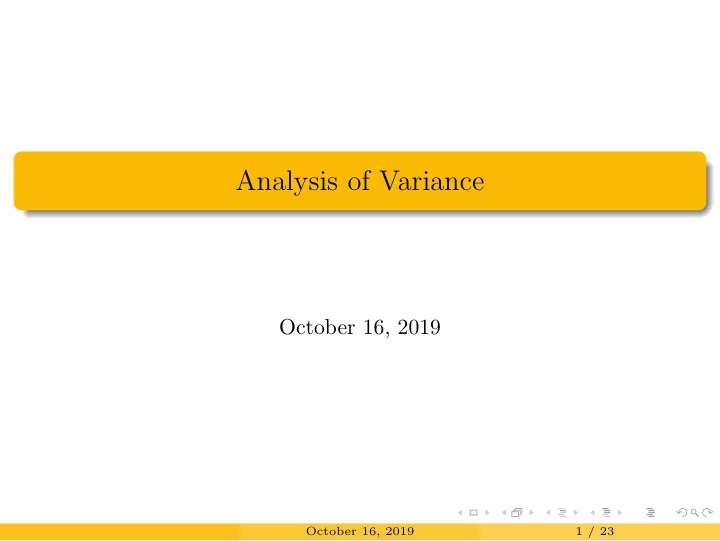

Analysis of Variance October 16, 2019 October 16, 2019 1 / 23
ANOVA and the F-test Question: is the variability in the sample means so large that it seems unlikely to be from chance alone? We call this variability the mean square between groups (MSG) or mean square for treatment (MST). Section 7.5 October 16, 2019 2 / 23
Mean Square Between Groups This acts as a measure of variability for the k group means. It has degrees of freedom d f G = k − 1. If H 0 is true, we expect this variability to be small. Section 7.5 October 16, 2019 3 / 23
Mean Square Between Groups 1 MSG = SSG d f G k 1 � x ) 2 = (¯ x i − ¯ k − 1 i =1 where SSG is the sum of squares between groups. Section 7.5 October 16, 2019 4 / 23
Mean Square Between Groups ...but MSG isn’t very useful on its own. Section 7.5 October 16, 2019 5 / 23
Mean Square Error We need an idea of how much variability would be expected (or normal) if H 0 were true. This is done using a pooled variance estimate, called the mean square error (MSE). This is a measure of variability within groups. MSE has degrees of freedom d f E = n − k Section 7.5 October 16, 2019 6 / 23
Mean Square Error 1 MSE = SSE d f E k 1 � ( n i − 1) s 2 = i n − k i =1 where SSE is the sum of squares for error and s i is the standard deviation for the observations in group i . Section 7.5 October 16, 2019 7 / 23
Sum of Squares Total It’s also useful to think of a sum of squares total (SST) SST = SSG + SSE and total degrees of freedom d f T = d f G + d f E = k − 1 + n − k = n − 1 Section 7.5 October 16, 2019 8 / 23
Mean Square Total If we were to find the mean square total, 1 MST = SST d f T 1 = n − 1( SSG + SST ) n 1 � x ) 2 = ( x i − ¯ n − 1 j =1 we would get the variance across all observations! Section 7.5 October 16, 2019 9 / 23
ANOVA The ANOVA breaks the variance down into within group (random) variability (MSE). between group (means) variability (MSG). Section 7.5 October 16, 2019 10 / 23
ANOVA We want to know how much variability is due to differences in groups relative to the within groups variability . So our test statistic is F = MSG MSE Section 7.5 October 16, 2019 11 / 23
Example For our baseball example, OF IF C Sample size ( n i ) 160 205 64 Sample mean (¯ x i ) 0.320 0.318 0.302 Sample sd ( s i ) 0.043 0.038 0.038 MSG = 0 . 00803 and MSE = 0 . 00158. Find the degrees of freedom and the F statistic. Section 7.5 October 16, 2019 12 / 23
The F Test With our F distribution comes the F-test . Using the F-distribution, we calculate F α ( d f 2 ) critical values. f 1 , d p-values Section 7.5 October 16, 2019 13 / 23
The F Test If the between-group variability is high relative to the within group variability, MSG > MSE F will be large. Large values of F represent stronger evidence against the null. Section 7.5 October 16, 2019 14 / 23
The F Test This is the F(2, 426) distribution from our baseball example. F-test p-values will always be from the upper tail area. We no longer have one- or two-sided tests to worry about. The critical value is F 0 . 05 (2 , 426) = 3 . 0169. Section 7.5 October 16, 2019 15 / 23
Example What can we conclude about the baseball field positions? Recall F 0 . 05 (2 , 426) = 3 . 0169. Section 7.5 October 16, 2019 16 / 23
Reading an ANOVA Table Typically we will run ANOVA using software. Fortunately there is a standard output for this analysis. Let’s take some time to write out the ANOVA table. Section 7.5 October 16, 2019 17 / 23
Reading an ANOVA Table from Software This is the ANOVA from R for the MLB example. Df Sum Sq Mean Sq F value Pr( > F) position 2 0.0161 0.0080 5.0766 0.0066 Residuals 426 0.6740 0.0016 What can we conclude based on the table? Section 7.5 October 16, 2019 18 / 23
Example Suppose we have 10 data points from each of 5 groups of interest. Source df SS MS F Group 3 Error Total 20 Fill in the missing information from the ANOVA table. Section 7.5 October 16, 2019 19 / 23
Graphical Diagnostics for ANOVA There are three conditions for ANOVA: 1 Independence 2 Approximate normality 3 Constant variance Section 7.5 October 16, 2019 20 / 23
ANOVA Diagnostics: Independence It is reasonable to assume independence if the data are a simple random sample. If the data are not a random sample, consider carefully. In the MLB example, no clear reason why a player’s batting stats would impact another player’s batting stats. Section 7.5 October 16, 2019 21 / 23
ANOVA Diagnostics: Normality Normality is especially important for small samples. For large samples, ANOVA is robust to deviations from normality. Section 7.5 October 16, 2019 22 / 23
ANOVA Diagnostics: Constant Variance We can check this visually or by examining the standard deviations for each group. Constant variance is especially important when the sample sizes differ between groups. Section 7.5 October 16, 2019 23 / 23
Recommend
More recommend